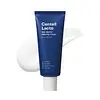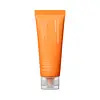What's inside
What's inside
 Key Ingredients
Key Ingredients

 Benefits
Benefits

 Concerns
Concerns

No concerns
 Ingredients Side-by-side
Ingredients Side-by-side

Centella Asiatica Leaf Extract 67.8%
Skin ConditioningGlycerin
HumectantButylene Glycol
HumectantCaprylic/Capric Triglyceride
Masking1,2-Hexanediol
Skin ConditioningHydrogenated Polydecene
EmollientNiacinamide
SmoothingHydrogenated Polyisobutene
EmollientOlea Europaea Fruit Oil
MaskingVinyldimethicone
Propanediol
SolventCetearyl Olivate
Water
Skin ConditioningCetearyl Alcohol
EmollientPolyglyceryl-2 Stearate
EmulsifyingSorbitan Olivate
EmulsifyingButyrospermum Parkii Butter
Skin ConditioningGlyceryl Stearate
EmollientStearyl Alcohol
EmollientCarbomer
Emulsion StabilisingCetyl Ethylhexanoate
EmollientTromethamine
BufferingHydroxyethyl Acrylate/Sodium Acryloyldimethyl Taurate Copolymer
Emulsion StabilisingEthylhexylglycerin
Skin ConditioningAdenosine
Skin ConditioningCeramide NP
Skin ConditioningHydrogenated Lecithin
EmulsifyingDisodium EDTA
Sorbitan Isostearate
EmulsifyingAllantoin
Skin ConditioningHyaluronic Acid
HumectantHydrolyzed Hyaluronic Acid
HumectantSodium Hyaluronate
HumectantSea Water
HumectantPanthenol
Skin ConditioningHippophae Rhamnoides Extract
MaskingDipropylene Glycol
HumectantCitrus Aurantium Bergamia Fruit Oil
MaskingOenothera Biennis Flower Extract
AstringentSalvia Miltiorrhiza Root Extract
Skin ConditioningPinus Pinaster Leaf Extract
Skin ConditioningUlmus Davidiana Root Extract
Skin ConditioningHydrolyzed Keratin
HumectantNelumbo Nucifera Flower Extract
Skin ConditioningMacadamia Integrifolia Seed Oil
Skin ConditioningMadecassic Acid
Skin ConditioningAsiaticoside
AntioxidantPhosphatidylcholine
EmulsifyingHouttuynia Cordata Extract
Skin ConditioningFructan
Skin ConditioningCamellia Sinensis Leaf Extract
AntimicrobialAsiatic Acid
Skin ConditioningAnastatica Hierochuntica Extract
AstringentPhytosteryl/Behenyl/Octyldodecyl Lauroyl Glutamate
Skin ConditioningCholesterol
EmollientAluminum/Magnesium Hydroxide Stearate
Emulsion StabilisingRetinol
Skin ConditioningBrassica Campestris Sterols
EmollientBifida Ferment Lysate
Skin ConditioningHydrolyzed Collagen
EmollientLactobacillus Ferment Lysate
Skin ConditioningLactococcus Ferment Lysate
Skin ConditioningVaccinium Macrocarpon Fruit Extract
AstringentBeta-Glucan
Skin ConditioningPotassium Cetyl Phosphate
EmulsifyingPentaerythrityl Tetra-Di-T-Butyl Hydroxyhydrocinnamate
AntioxidantGlycine
BufferingSerine
MaskingGlutamic Acid
HumectantMadecassoside
AntioxidantAspartic Acid
MaskingLeucine
Skin ConditioningAlanine
MaskingLysine
Skin ConditioningArginine
MaskingTyrosine
MaskingPhenylalanine
MaskingProline
Skin ConditioningThreonine
Valine
MaskingIsoleucine
Skin ConditioningHistidine
HumectantCysteine
AntioxidantMethionine
Skin ConditioningMelaleuca Alternifolia Leaf Extract
PerfumingHeparin
Skin ConditioningCentella Asiatica Leaf Extract 67.8%, Glycerin, Butylene Glycol, Caprylic/Capric Triglyceride, 1,2-Hexanediol, Hydrogenated Polydecene, Niacinamide, Hydrogenated Polyisobutene, Olea Europaea Fruit Oil, Vinyldimethicone, Propanediol, Cetearyl Olivate, Water, Cetearyl Alcohol, Polyglyceryl-2 Stearate, Sorbitan Olivate, Butyrospermum Parkii Butter, Glyceryl Stearate, Stearyl Alcohol, Carbomer, Cetyl Ethylhexanoate, Tromethamine, Hydroxyethyl Acrylate/Sodium Acryloyldimethyl Taurate Copolymer, Ethylhexylglycerin, Adenosine, Ceramide NP, Hydrogenated Lecithin, Disodium EDTA, Sorbitan Isostearate, Allantoin, Hyaluronic Acid, Hydrolyzed Hyaluronic Acid, Sodium Hyaluronate, Sea Water, Panthenol, Hippophae Rhamnoides Extract, Dipropylene Glycol, Citrus Aurantium Bergamia Fruit Oil, Oenothera Biennis Flower Extract, Salvia Miltiorrhiza Root Extract, Pinus Pinaster Leaf Extract, Ulmus Davidiana Root Extract, Hydrolyzed Keratin, Nelumbo Nucifera Flower Extract, Macadamia Integrifolia Seed Oil, Madecassic Acid, Asiaticoside, Phosphatidylcholine, Houttuynia Cordata Extract, Fructan, Camellia Sinensis Leaf Extract, Asiatic Acid, Anastatica Hierochuntica Extract, Phytosteryl/Behenyl/Octyldodecyl Lauroyl Glutamate, Cholesterol, Aluminum/Magnesium Hydroxide Stearate, Retinol, Brassica Campestris Sterols, Bifida Ferment Lysate, Hydrolyzed Collagen, Lactobacillus Ferment Lysate, Lactococcus Ferment Lysate, Vaccinium Macrocarpon Fruit Extract, Beta-Glucan, Potassium Cetyl Phosphate, Pentaerythrityl Tetra-Di-T-Butyl Hydroxyhydrocinnamate, Glycine, Serine, Glutamic Acid, Madecassoside, Aspartic Acid, Leucine, Alanine, Lysine, Arginine, Tyrosine, Phenylalanine, Proline, Threonine, Valine, Isoleucine, Histidine, Cysteine, Methionine, Melaleuca Alternifolia Leaf Extract, Heparin
Hippophae Rhamnoides Fruit Extract
Skin ConditioningGlycerin
HumectantGlycereth-26
HumectantNiacinamide
SmoothingCaprylic/Capric/Succinic Triglyceride
EmollientWater
Skin ConditioningButylene Glycol
Humectant1,2-Hexanediol
Skin ConditioningHydrogenated Poly(C6-14 Olefin)
EmollientPolyglyceryl-4 Caprate
EmulsifyingAstaxanthin
Skin ConditioningHaematococcus Pluvialis Oil
AntioxidantGluconolactone
Skin ConditioningGlyceryl Glucoside
HumectantXylitylglucoside
HumectantAnhydroxylitol
HumectantCarthamus Tinctorius Seed Oil
MaskingAdenosine
Skin ConditioningXylitol
HumectantBisabolol
MaskingTranexamic Acid
AstringentGlutathione
Hippophae Rhamnoides Fruit Oil
Skin ProtectingMoringa Oleifera Seed Oil
EmollientGlucose
HumectantTocopherol
AntioxidantBiota Orientalis Leaf Extract
HumectantZanthoxylum Piperitum Fruit Extract
Skin ConditioningUbiquinone
AntioxidantEclipta Prostrata Extract
Skin ConditioningMelia Azadirachta Leaf Extract
Skin ConditioningPolygonum Cuspidatum Root Extract
AntioxidantCetearyl Olivate
Sorbitan Olivate
EmulsifyingAmmonium Acryloyldimethyltaurate/Vp Copolymer
Carbomer
Emulsion StabilisingArginine
MaskingCaprylyl Glycol
EmollientEthylhexylglycerin
Skin ConditioningAgar
MaskingDisodium EDTA
Hippophae Rhamnoides Fruit Extract, Glycerin, Glycereth-26, Niacinamide, Caprylic/Capric/Succinic Triglyceride, Water, Butylene Glycol, 1,2-Hexanediol, Hydrogenated Poly(C6-14 Olefin), Polyglyceryl-4 Caprate, Astaxanthin, Haematococcus Pluvialis Oil, Gluconolactone, Glyceryl Glucoside, Xylitylglucoside, Anhydroxylitol, Carthamus Tinctorius Seed Oil, Adenosine, Xylitol, Bisabolol, Tranexamic Acid, Glutathione, Hippophae Rhamnoides Fruit Oil, Moringa Oleifera Seed Oil, Glucose, Tocopherol, Biota Orientalis Leaf Extract, Zanthoxylum Piperitum Fruit Extract, Ubiquinone, Eclipta Prostrata Extract, Melia Azadirachta Leaf Extract, Polygonum Cuspidatum Root Extract, Cetearyl Olivate, Sorbitan Olivate, Ammonium Acryloyldimethyltaurate/Vp Copolymer, Carbomer, Arginine, Caprylyl Glycol, Ethylhexylglycerin, Agar, Disodium EDTA
Ingredients Explained
These ingredients are found in both products.
Ingredients higher up in an ingredient list are typically present in a larger amount.
1,2-Hexanediol is a synthetic liquid and another multi-functional powerhouse.
It is a:
- Humectant, drawing moisture into the skin
- Emollient, helping to soften skin
- Solvent, dispersing and stabilizing formulas
- Preservative booster, enhancing the antimicrobial activity of other preservatives
Adenosine is in every living organism. It is one of four components in nucleic acids that helps store our DNA.
Adenosine has many benefits when used. These benefits include hydrating the skin, smoothing skin, and reducing wrinkles. Once applied, adenosine increases collagen production. It also helps with improving firmness and tissue repair.
Studies have found adenosine may also help with wound healing.
In skincare products, Adenosine is usually derived from yeast.
Learn more about AdenosineArginine is an amino acid that is important for human development. Your body uses is it to produce hair keratin and skin collagen.
As a cosmetic ingredient, Arginine has antioxidant properties and can also help repair damaged skin. This ingredient is derived either synthetically or from animals.
Arginine isn't fungal acne safe when used in the presence of other lipids (fats, fatty acids, oils, esters, etc). Oils and fats occur naturally within the skin, so take caution when using Arginine if you're prone to fungal acne.
Learn more about ArginineButylene Glycol (or BG) is used within cosmetic products for a few different reasons:
Overall, Butylene Glycol is a safe and well-rounded ingredient that works well with other ingredients.
Though this ingredient works well with most skin types, some people with sensitive skin may experience a reaction such as allergic rashes, closed comedones, or itchiness.
Learn more about Butylene GlycolCarbomer is a polymer of acrylic acid. Its main role is to create a gel consistency.
A high amount of carbomer can cause pilling or balling up of products. Don't worry, most products contain 1% or less of carbomer.
Cetearyl Olivate is an emulsifier and texture enhancer. It is derived from the fatty acids of olive oil and Cetearyl alcohol, and is biodegradable.
As an emulsifier, it is used to prevent oils and waters from separating. It can also
Manufacturers use the name Olivem 1000. This ingredient has been found to preserve the natural microbiome of skin. Having a healthy microbiome helps keep our skin healthy and protects against harmful bacteria. This ingredient is grouped with Sorbitan Olivate under the name Olivem 1000.
Learn more about Cetearyl OlivateDisodium EDTA plays a role in making products more stable by aiding other preservatives.
It is a chelating agent, meaning it neutralizes metal ions that may be found in a product.
Disodium EDTA is a salt of edetic acid and is found to be safe in cosmetic ingredients.
Learn more about Disodium EDTAEthylhexylglycerin (we can't pronounce this either) is commonly used as a preservative and skin softener. It is derived from glyceryl.
You might see Ethylhexylglycerin often paired with other preservatives such as phenoxyethanol. Ethylhexylglycerin has been found to increase the effectiveness of these other preservatives.
Glycerin is already naturally found in your skin. It helps moisturize and protect your skin.
A study from 2016 found glycerin to be more effective as a humectant than AHAs and hyaluronic acid.
As a humectant, it helps the skin stay hydrated by pulling moisture to your skin. The low molecular weight of glycerin allows it to pull moisture into the deeper layers of your skin.
Hydrated skin improves your skin barrier; Your skin barrier helps protect against irritants and bacteria.
Glycerin has also been found to have antimicrobial and antiviral properties. Due to these properties, glycerin is often used in wound and burn treatments.
In cosmetics, glycerin is usually derived from plants such as soybean or palm. However, it can also be sourced from animals, such as tallow or animal fat.
This ingredient is organic, colorless, odorless, and non-toxic.
Glycerin is the name for this ingredient in American English. British English uses Glycerol/Glycerine.
Learn more about GlycerinNiacinamide is a multitasking form of vitamin B3 that strengthens the skin barrier, reduces pores and dark spots, regulates oil, and improves signs of aging.
And the best part? It's gentle and well-tolerated by most skin types, including sensitive and reactive skin.
You might have heard of "niacin flush", or the reddening of skin that causes itchiness. Niacinamide has not been found to cause this.
In very rare cases, some individuals may not be able to tolerate niacinamide at all or experience an allergic reaction to it.
If you are experiencing flaking, irritation, and dryness with this ingredient, be sure to double check all your products as this ingredient can be found in all categories of skincare.
When incorporating niacinamide into your routine, look out for concentration amounts. Typically, 5% niacinamide provides benefits such as fading dark spots. However, if you have sensitive skin, it is better to begin with a smaller concentration.
When you apply niacinamide to your skin, your body converts it into nicotinamide adenine dinucleotide (NAD). NAD is an essential coenzyme that is already found in your cells as "fuel" and powers countless biological processes.
In your skin, NAD helps repair cell damage, produce new healthy cells, support collagen production, strengthen the skin barrier, and fight environmental stressors (like UV and pollution).
Our natural NAD levels start to decline with age, leading to slower skin repair, visible aging, and a weaker skin barrier. By providing your skin niacinamide, you're recharging your skin's NAD levels. This leads to stronger, healthier, and younger looking skin.
Another name for vitamin B3 is nicotinamide. This vitamin is water-soluble and our bodies don't store it. We obtain Vitamin B3 from either food or skincare. Meat, fish, wheat, yeast, and leafy greens contain vitamin B3.
The type of niacinamide used in skincare is synthetically created.
Learn more about NiacinamideSorbitan Olivate is created from the fatty acids in olive oil and sorbitol.
This ingredient is an oil in water emulsifier. It helps stabilize a product by preventing oils and waters from separating. Sorbitan Olivate also helps hydrate the skin.
Manufacturers sell sorbitan olivate under the name OliveM 1000. OliveM 1000 a multifunctional ingredient. It is self-emulsifying. According to a manufacturer, OliveM 1000 does not disrupt natural skin biome.
Due to its olive oil base, this ingredient may not be fungal-acne safe.
Learn more about Sorbitan OlivateWater. It's the most common cosmetic ingredient of all. You'll usually see it at the top of ingredient lists, meaning that it makes up the largest part of the product.
So why is it so popular? Water most often acts as a solvent - this means that it helps dissolve other ingredients into the formulation.
You'll also recognize water as that liquid we all need to stay alive. If you see this, drink a glass of water. Stay hydrated!
Learn more about Water